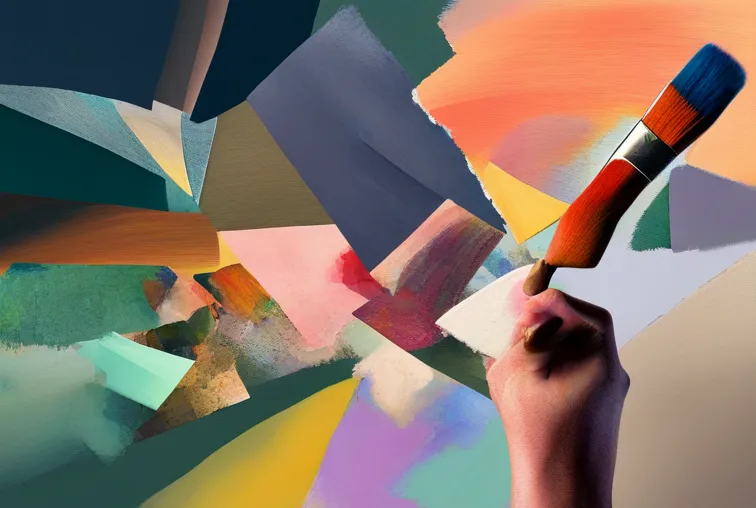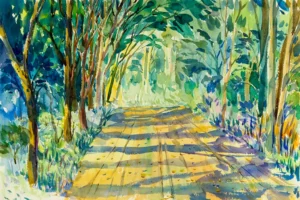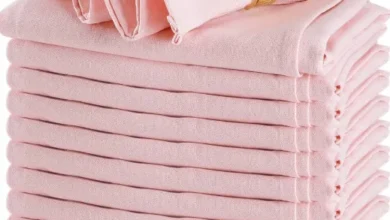Mixed Media Art Ideas: Discover Your Creative Fusion

Mixed media art combines various materials like paint, fabric, and paper to create unique pieces. Artists often blend textures and techniques.
Mixed-media art offers endless possibilities for creativity. By merging different materials, artists can achieve unique and captivating effects. Common elements include acrylics, watercolours, charcoal, and fabric. These materials allow for layering, adding depth and dimension to the artwork. Mixed-media art also encourages experimentation, making it perfect for both beginners and experienced artists.
Techniques like collage, assemblage, and altered books are popular. This versatile art form can be tailored to individual styles and preferences. Mixed-media art fosters innovation and personal expression, making it a rewarding endeavour for anyone passionate about creativity.
Contents
The Essence Of Mixed Media Art

Mixed-media art is a unique form of expression that combines different materials and techniques. This art form allows for endless creativity. Artists can use paint, fabric, paper, and found objects. The possibilities are endless with mixed-media art.
Defining Mixed Media
Mixed-media art involves using more than one medium in a single artwork. For example, an artist might combine watercolour and ink. Another might use acrylic paint with collage elements. This method creates depth and texture in the artwork and allows artists to explore different styles and ideas.
Historical Evolution Of Mixed Media Art
Mixed-media art has a rich history. It began in the early 20th century. Artists like Pablo Picasso and Georges Braque pioneered this form. They used collage in their Cubist works, a revolutionary idea that challenged traditional notions of art at the time.
| Artist | Contribution |
| Pablo Picasso | Introduced collage in Cubism. |
| Georges Braque | Used mixed media in Cubist works. |
In the 1960s, mixed-media art became more popular. Artists started using everyday objects in their work, and this trend continues today. Mixed-media art allows for limitless creativity.
Mixed-media art is dynamic and ever-evolving. It reflects the artist’s imagination and creativity. Each piece tells a unique story. It invites viewers to explore and interpret. Mixed-media art is genuinely limitless.
Materials And Tools
Mixed media art combines different art materials and tools to create unique pieces. Choosing the right supplies can enhance your creativity. Whether you are a beginner or an experienced artist, having the right tools is essential.
Basic Supplies For Beginners
If you are new to mixed media art, start with basic supplies. These materials are easy to find and use.
- Acrylic Paints: Versatile and quick-drying, perfect for layering.
- Watercolours: Ideal for creating soft backgrounds and washes.
- Markers: Great for adding details and outlines.
- Coloured Pencils: Excellent for fine details and shading.
- Sketch Pads: Use them to plan and test your ideas.
- Glue Sticks: Easy to use for attaching paper elements.
- Scissors: Essential for cutting paper and other materials.
Advanced Materials For Experienced Artists
Experienced artists may want to explore more advanced materials. These tools can add complexity and depth to your work.
- Gel Mediums: Use to create texture and depth in your paintings.
- Oil Pastels: Vibrant colours, perfect for blending.
- Ink Pens: Ideal for intricate details and fine lines.
- Gesso: Prepares surfaces for painting and adds texture.
- Collage Papers: Use different papers to create interesting layers.
- Stencils: Add patterns and shapes with ease.
- Embossing Tools: Create raised designs for a tactile element.
Techniques To Master
Mixed media art combines various artistic methods. It’s a fun way to express your creativity. Learning essential techniques can elevate your artwork. Below, we will explore some essential techniques to master.
Layering Essentials
Layering is a crucial technique in mixed media art. It involves adding different materials on top of each other. This creates depth and interest in your piece. Start with a base layer. This could be paint, paper, or fabric.
Next, add layers using different materials. Consider using stencils, stamps, or collage pieces. Make sure each layer is dry before adding the next. This prevents smudging and keeps your work clean.
Tools you might need:
- Brushes
- Sponges
- Stencil sheets
- Mod Podge
Tips:
- Use thin layers to gradually build up texture.
- Experiment with different materials to see what works best.
Incorporating Textures And Patterns
Textures and patterns add a tactile element to your artwork and make your pieces more engaging. Use materials like fabric, sand, or modelling paste to create texture. Apply these materials to your base layer.
Patterns can be added using stamps, stencils, or by hand. Try to mix different patterns for an exciting look. For example, combine geometric shapes with organic forms.
Texture Ideas:
- Burlap fabric
- Sandpaper
- Embossing paste
Pattern Ideas:
- Chevron stripes
- Polka dots
- Floral motifs
Finding Inspiration

Finding inspiration for mixed media art can transform a simple project into a masterpiece. Whether you are an experienced artist or a beginner, exploring different sources of inspiration can spark creativity and innovation. Let’s dive into some unique ideas to help you find that perfect muse.
Drawing From Nature
Nature is an endless source of inspiration for mixed media art. The colours, textures, and shapes found in the natural world can be translated into stunning artwork.
- Leaves and Flowers: Collect leaves and flowers to press or use as stamps.
- Rocks and Stones: Use their textures by rubbingporating rubbings.
- Water and Sky: The changing colours of water and sky can inspire beautiful backgrounds.
Next time you take a walk, observe the natural elements around you. Snap photos of exciting patterns or sketch scenes that catch your eye. These can serve as references for your mixed media projects.
Urban Landscapes As A Muse
Urban environments offer a rich tapestry of inspiration for mixed-media art. The gritty textures, vibrant graffiti, and unique architectural elements can be used creatively.
- Graffiti Art: Incorporate graffiti elements to add a modern edge to your work.
- Cityscapes: Use the skyline or specific buildings as focal points.
- Textures: Capture the textures of brick walls, metal, and concrete through rubbings or photographs.
Explore your city with a camera or sketchbook in hand. Document interesting scenes and collect materials like flyers or tickets to include in your art.
| Source of Inspiration | Ideas for Mixed Media Art |
| Nature | Leaves, rocks, water, sky patterns |
| Urban Landscapes | Graffiti, cityscapes, textures of buildings |
Combining Different Art Forms
Mixed-media art involves combining different art forms to create unique and captivating pieces. Various materials and techniques are available, opening up endless possibilities. Let’s explore some exciting ideas.
Integrating Photography And Painting
Photography and painting can blend beautifully. Start by taking a photo that inspires you. Print it on a canvas. Then, use paints to enhance or alter the image. You can add colors, textures, and patterns, creating a rich visual effect.
Consider using acrylic paints. They dry fast and work well on photos. Watercolours can add a soft touch. Use oil paints for a bold look. The key is to experiment and have fun.
Sculpture Meets Collage
Sculpture and collage can create stunning three-dimensional art. Begin with a base sculpture. It can be made of clay, wood, or metal. Then, add collage elements. Use paper, fabric, or found objects. This adds depth and interest to your piece.
Layering materials gives your work texture. Attach collage pieces with glue or adhesive. Paint can be added for extra flair. Your imagination is the limit!
| Material | Best Use |
| Acrylic Paints | Fast drying, suitable for layering on photos |
| Watercolors | Soft, translucent effects on photos |
| Oil Paints | Bold and vibrant effects |
| Clay | Base material for sculptures |
| Fabric | Adding texture in collages |
Digital Meets Physical
Mixed-media art is evolving rapidly. Artists are now blending digital elements with physical materials, creating stunning and unique artworks. The fusion of digital and physical art opens endless possibilities. Let’s explore how to combine these two worlds effectively.
Incorporating Digital Elements
Digital elements can add a modern touch to your art. You can print digital patterns on canvas or paper. Use a printer to transfer your digital designs onto physical surfaces. This adds a unique dimension to your artwork.
You can also use digital tools to enhance your physical art. Tablets and graphic software help you draft initial designs. Then, you can transfer these drafts to traditional mediums. This ensures precision and creativity.
| Digital Tools | Usage |
| Graphic Tablets | Create initial designs |
| Printers | Transfer digital patterns |
| Graphic Software | Edit and enhance artwork |
Blending Traditional Techniques With New Media
Combining traditional techniques with new media can be very exciting. For example, you can paint over printed digital designs, adding texture and depth to your artwork. Mixing paints with digital prints creates unique effects.
Collage is another excellent way to blend old and new. Physical materials like paper, fabric, and found objects combined with digital prints and photos create a rich and layered effect.
- Paint Over Prints: Add texture and depth.
- Collage: Mix physical and digital materials.
- Layering: Use multiple mediums for a rich effect.
Thematic Mixed Media Projects
Thematic mixed media projects allow artists to explore deep themes and stories. These projects combine various materials and techniques. Artists can express personal experiences and social issues using these projects.
Personal Narratives Through Art
Personal narratives can be powerful in mixed-media art. Artists can use different materials to tell their own stories, and photos, letters, and sketches can be combined to create a unique piece.
For example:
- Family photos layered with paint and fabric
- Old letters mixed with abstract art
- Sketches combined with digital prints
Social Commentary And Artistic Expression
Mixed media art is perfect for making social commentary. Artists can use their work to speak about important issues. Combining materials like newspaper clippings, paint, and found objects can make a strong statement.
Some ideas include:
- Collages that highlight environmental issues
- Assemblages that show cultural diversity
- Mixed media portraits addressing social justice
| Material | Use |
| Newspaper Clippings | Highlight current events |
| Found Objects | Represent everyday life |
| Fabric | Add texture and depth |
Showcasing Your Work
Showcasing your mixed media art is essential to the artist’s journey. It allows you to share your unique vision with the world. Whether you prefer physical exhibits or digital platforms, seeing your work can open many doors.
Exhibiting Mixed Media Art
Exhibiting mixed-media art in galleries provides a tactile experience for viewers, allowing them to see the textures and layers up close. Consider local art shows and community centres. These venues often support emerging artists and offer a welcoming environment.
Prepare your pieces well. Frame your artwork to enhance its beauty. Label your work with titles and descriptions. This helps viewers connect with your pieces on a deeper level.
| Venue Type | Benefits |
| Local Art Shows | Community support, networking opportunities |
| Community Centers | Low entry costs, supportive environment |
| Galleries | Professional exposure, potential sales |
Digital Platforms For Artists
Digital platforms provide a global audience for your art. They are accessible and easy to use. Social media sites like Instagram and Facebook are excellent starting points. They allow you to post photos and engage with followers.
Consider creating a personal website. Websites give you complete control over how your work is presented. Platforms like WordPress and Wix make it simple to build a site. Include a gallery, artist bio, and contact information.
- Instagram: Share photos, use hashtags
- Facebook: Create an artist page, engage with fans
- Personal Website: Full control, professional look
Online galleries are also a great option. Sites like Saatchi Art and Etsy cater to artists. They offer tools for selling your work and reaching new audiences.
Workshops And Community
Mixed media art is a vibrant and expressive form of creativity. It combines various materials and techniques to create unique artworks. Workshops and community play a significant role in enhancing your skills and finding inspiration. Engaging with others can open new doors and provide endless ideas.
Finding Local Art Workshops
Local art workshops offer hands-on experience with mixed-media techniques. They are excellent for learning from experienced artists and connecting with like-minded individuals. You can find workshops by visiting local art studios, community centres, and colleges.
Benefits of Local Workshops:
- Hands-on learning
- Direct feedback from experts
- Networking opportunities
Check bulletin boards at libraries and art supply stores for upcoming events. Many cities have art councils that list local workshops on their websites. Feel free to ask local artists about any workshops they might offer.
Joining Online Mixed Media Communities
Online communities offer a platform to share your artwork and get feedback. They are also a great place to find inspiration and learn new techniques. Platforms like Facebook, Instagram, and dedicated art forums have thriving communities of mixed-media artists.
Popular Online Platforms:
| Platform | Features |
| Facebook Groups | Discussion, Sharing, Tutorials |
| Photo Sharing, Hashtags, Stories | |
| Art Forums | Discussions, Critiques, Challenges |
Joining these communities can connect you with artists worldwide. Many platforms also offer live sessions and workshops, which allow you to learn from the comfort of your home.
Challenges And Solutions
Creating mixed-media art can be a fulfilling experience. Yet artists often face challenges that can slow down their progress. This section addresses these common issues and offers practical solutions.
Common Mixed Media Art Challenges
Mixed media art involves combining various materials and techniques. This can lead to a range of challenges. Here are some common issues:
- Material Compatibility: Different materials may not adhere well to each other. This can cause your artwork to fall apart.
- Colour Clashing: Mixing multiple colours can result in a chaotic look. Some colours may need to blend better.
- Time Management: Mixed media projects can be time-consuming. Artists may need help to complete their work on schedule.
These challenges can be frustrating, but don’t worry! Solutions are available to help you navigate them.
Troubleshooting Creative Blocks
Creative blocks are another common hurdle. Here are some tips to overcome them:
- Take a Break: Sometimes, stepping away from your work can help. A short break can refresh your mind.
- Seek Inspiration: Look at other mixed media art pieces. This can spark new ideas.
- Experiment with New Techniques: Trying something new can reignite your creativity. Feel free to explore.
By addressing these challenges, you can improve your mixed media art skills. Keep experimenting and stay motivated!
Conclusion
Mixed-media art offers endless possibilities for creativity. Experiment with different materials and techniques to find your unique style. Remember, the journey is as important as the final piece. Dive into the world of mixed media and let your imagination soar.

